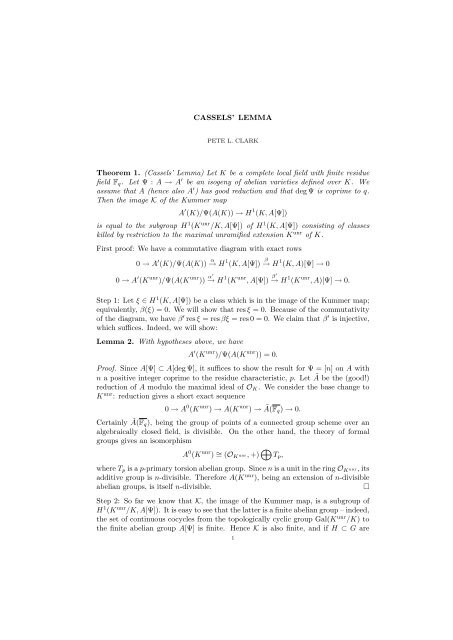CASSELS' LEMMA Theorem 1. (Cassels' Lemma) Let K be a ...
CASSELS' LEMMA Theorem 1. (Cassels' Lemma) Let K be a ...
CASSELS' LEMMA Theorem 1. (Cassels' Lemma) Let K be a ...
Create successful ePaper yourself
Turn your PDF publications into a flip-book with our unique Google optimized e-Paper software.
CASSELS’ <strong>LEMMA</strong><br />
PETE L. CLARK<br />
<strong>Theorem</strong> <strong>1.</strong> (Cassels’ <strong>Lemma</strong>) <strong>Let</strong> K <strong>be</strong> a complete local field with finite residue<br />
field F q . <strong>Let</strong> Ψ : A → A ′ <strong>be</strong> an isogeny of a<strong>be</strong>lian varieties defined over K. We<br />
assume that A (hence also A ′ ) has good reduction and that deg Ψ is coprime to q.<br />
Then the image K of the Kummer map<br />
A ′ (K)/Ψ(A(K)) → H 1 (K, A[Ψ])<br />
is equal to the subgroup H 1 (K unr /K, A[Ψ]) of H 1 (K, A[Ψ]) consisting of classes<br />
killed by restriction to the maximal unramified extension K unr of K.<br />
First proof: We have a commutative diagram with exact rows<br />
0 → A ′ (K)/Ψ(A(K)) α → H 1 (K, A[Ψ]) β → H 1 (K, A)[Ψ] → 0<br />
0 → A ′ (K unr )/Ψ(A(K unr )) → α′<br />
H 1 (K unr , A[Ψ]) → β′<br />
H 1 (K unr , A)[Ψ] → 0.<br />
Step 1: <strong>Let</strong> ξ ∈ H 1 (K, A[Ψ]) <strong>be</strong> a class which is in the image of the Kummer map;<br />
equivalently, β(ξ) = 0. We will show that res ξ = 0. Because of the commutativity<br />
of the diagram, we have β ′ res ξ = res βξ = res 0 = 0. We claim that β ′ is injective,<br />
which suffices. Indeed, we will show:<br />
<strong>Lemma</strong> 2. With hypotheses above, we have<br />
A ′ (K unr )/Ψ(A(K unr )) = 0.<br />
Proof. Since A[Ψ] ⊂ A[deg Ψ], it suffices to show the result for Ψ = [n] on A with<br />
n a positive integer coprime to the residue characteristic, p. <strong>Let</strong> Ã <strong>be</strong> the (good!)<br />
reduction of A modulo the maximal ideal of O K . We consider the base change to<br />
K unr : reduction gives a short exact sequence<br />
0 → A 0 (K unr ) → A(K unr ) → Ã(F q) → 0.<br />
Certainly Ã(F q), <strong>be</strong>ing the group of points of a connected group scheme over an<br />
algebraically closed field, is divisible. On the other hand, the theory of formal<br />
groups gives an isomorphism<br />
A 0 (K unr ) ∼ = (O K unr, +) ⊕ T p ,<br />
where T p is a p-primary torsion a<strong>be</strong>lian group. Since n is a unit in the ring O K unr, its<br />
additive group is n-divisible. Therefore A(K unr ), <strong>be</strong>ing an extension of n-divisible<br />
a<strong>be</strong>lian groups, is itself n-divisible.<br />
□<br />
Step 2: So far we know that K, the image of the Kummer map, is a subgroup of<br />
H 1 (K unr /K, A[Ψ]). It is easy to see that the latter is a finite a<strong>be</strong>lian group – indeed,<br />
the set of continuous cocycles from the topologically cyclic group Gal(K unr /K) to<br />
the finite a<strong>be</strong>lian group A[Ψ] is finite. Hence K is also finite, and if H ⊂ G are<br />
1
2 PETE L. CLARK<br />
finite a<strong>be</strong>lian groups, to show that H = G it suffices to show that #H = #G.<br />
We recall the following result of basic Galois cohomology of Ẑ = Gal(Kunr /K).<br />
If M is a finite Ẑ-module, then<br />
H 1 (Ẑ, M) ∼ = M/(F − 1)M,<br />
where F is the Fro<strong>be</strong>nius map, the distinguished topological generator of Ẑ. Reduction<br />
induces an isomorphism on the n-torsion, so A[ψ](K) = A[ψ](K unr ); we<br />
abbreviate this as A[ψ] and write A[ψ](K) for the subgroup of K-rational points,<br />
which is precisely the kernel of F − <strong>1.</strong> So we have<br />
H 1 (K unr /K, A[Ψ]) ∼ = A[ψ]/(F − 1)A[Ψ].<br />
Next a tiny piece of pure algebra: let M <strong>be</strong> a finite a<strong>be</strong>lian group and ϕ an endomorphism<br />
of M. Then contemplation of the short exact sequence<br />
0 → ker ϕ → M ϕ → M → coker ϕ → 0<br />
gives # ker ϕ = # coker ϕ. Applying this with M = A[ϕ] and ϕ equal to F − 1, we<br />
get<br />
#H 1 (K unr /K, A[Ψ]) = #A[Ψ]/(F −1)A[Ψ] = # coker ϕ = #kerϕ = #A[Ψ](K) = #Ã[Ψ](F q).<br />
On the other hand, <strong>be</strong>cause Ψ is surjective on the kernel of reduction, we have<br />
#K = #A ′ (K)/Ψ(A(K)) = #Ã′ (F q )/ ˜ΨÃ(F q).<br />
Note that since à and Ã′ are F q -rationally isogenous, #Ã(F q) = #Ã′ (F q ). Therefore,<br />
applying a similar counting argument to the exact sequence<br />
we conclude<br />
qed.<br />
0 → Ã(F q)[ ˜Ψ] → Ã(F q) → Ã′ (F q ) → #Ã′ (F q )/ ˜ΨÃ(F q) = 0,<br />
#H 1 (K unr /K, A[Ψ]) = #Ã(F q)[ ˜Ψ] = #Ã′ (F q )/ ˜ΨÃ(F q) = #K,



